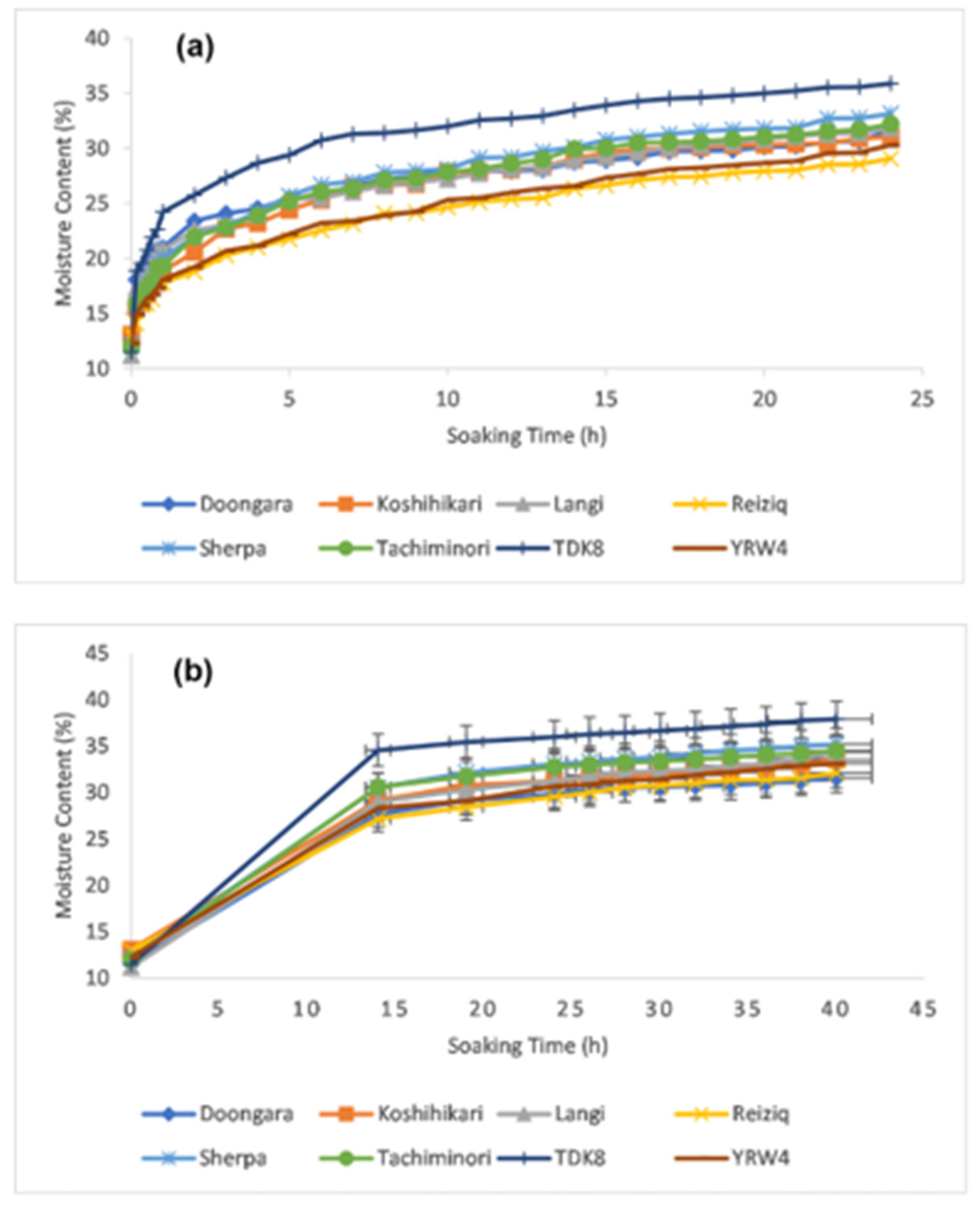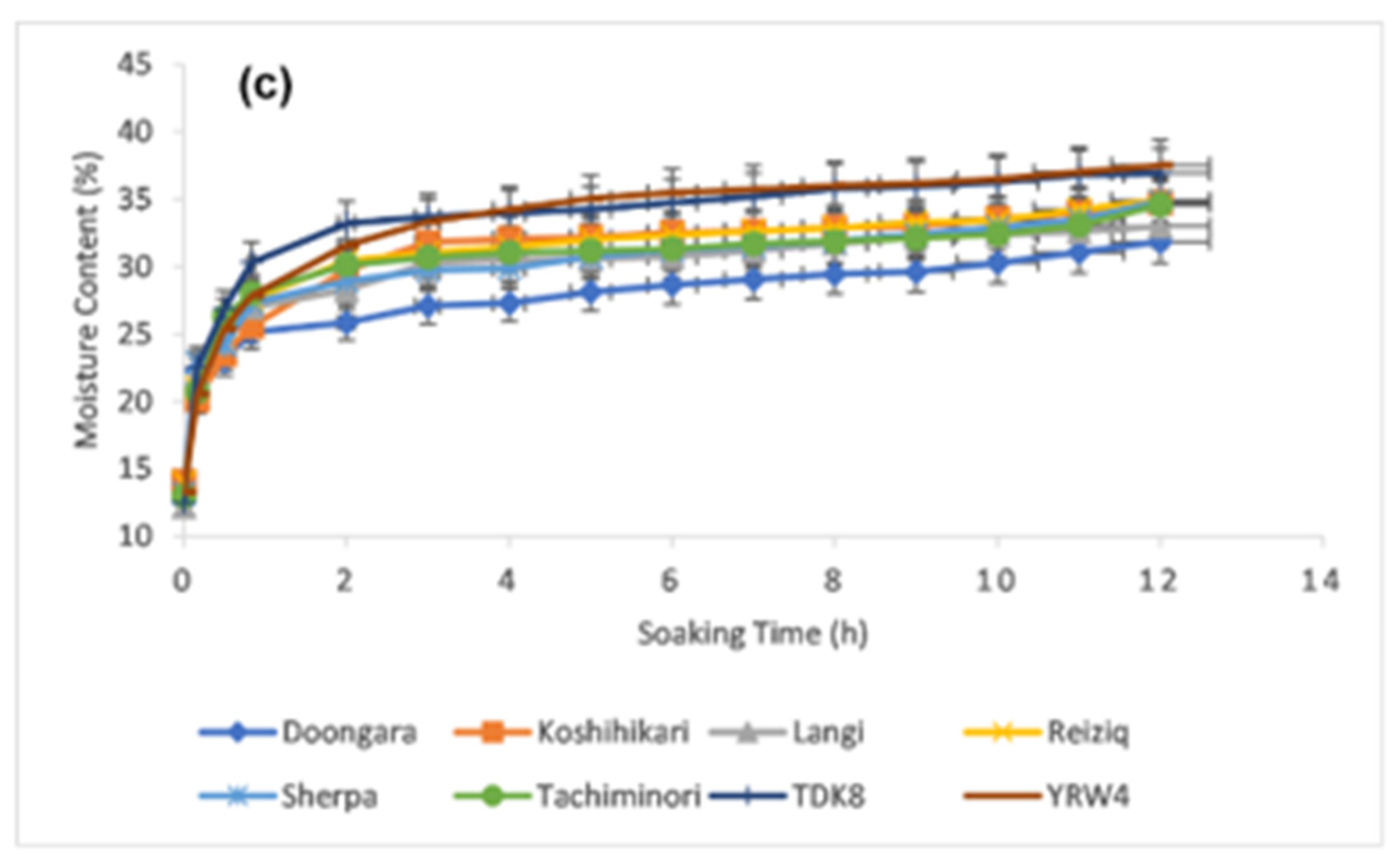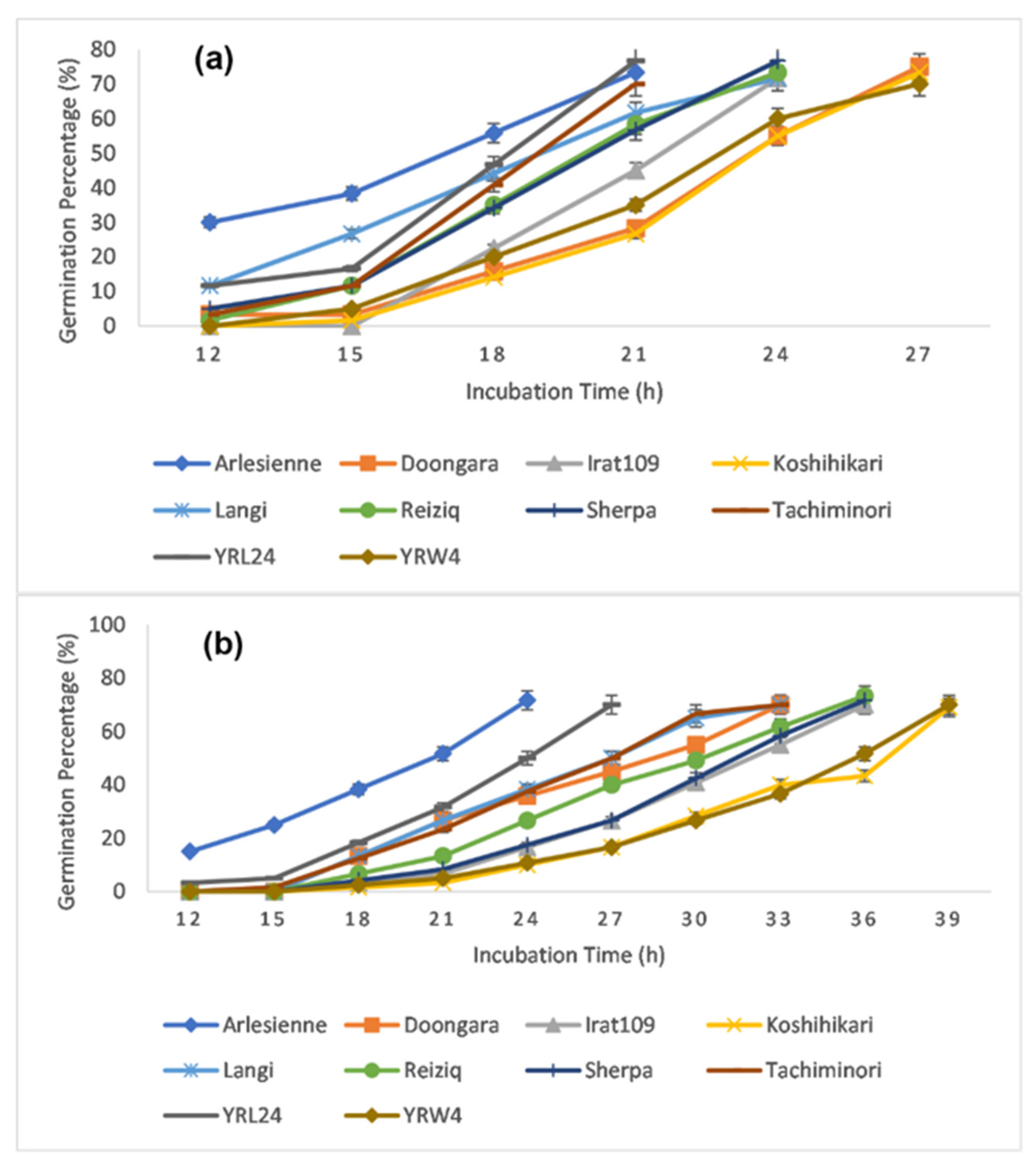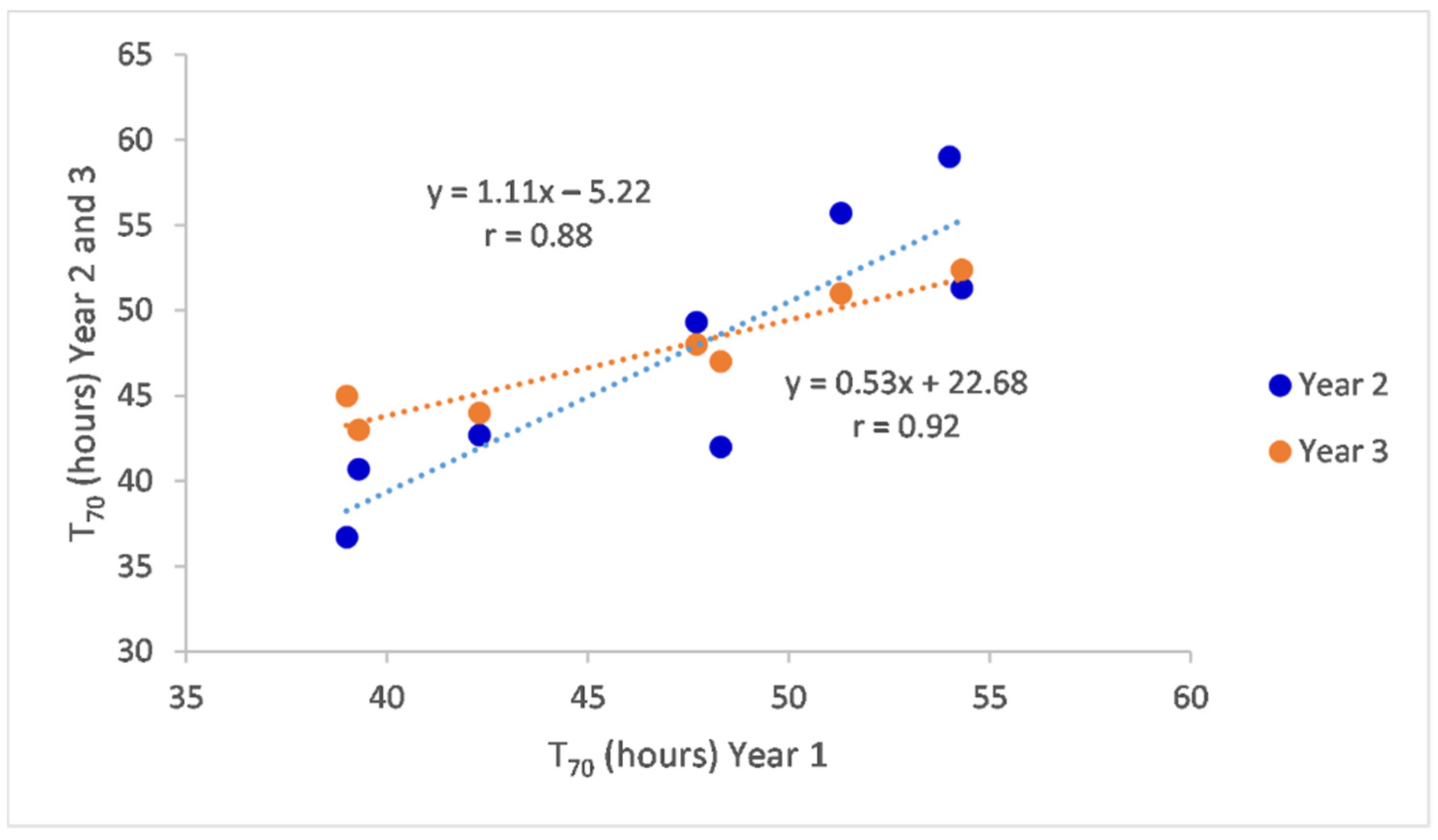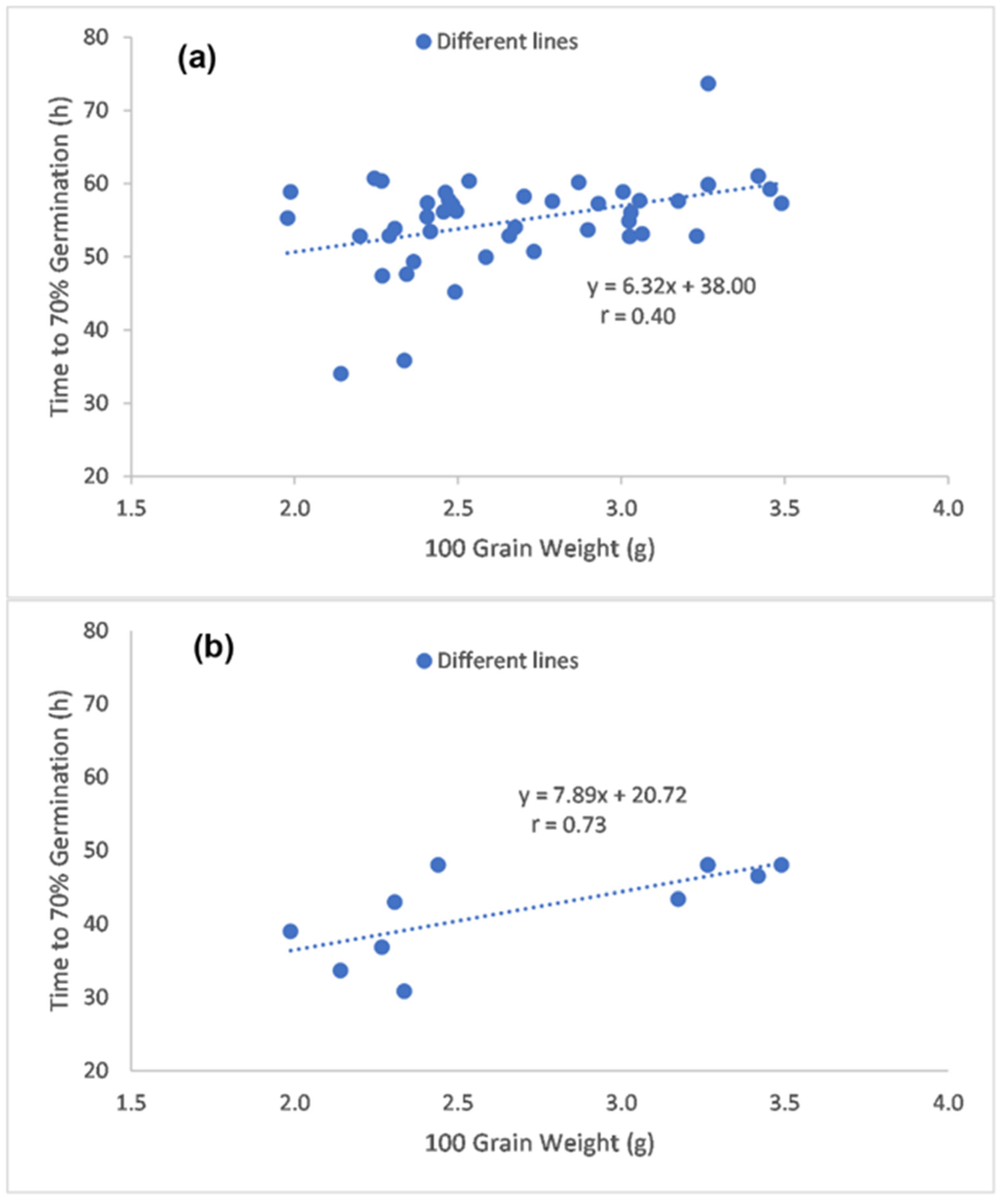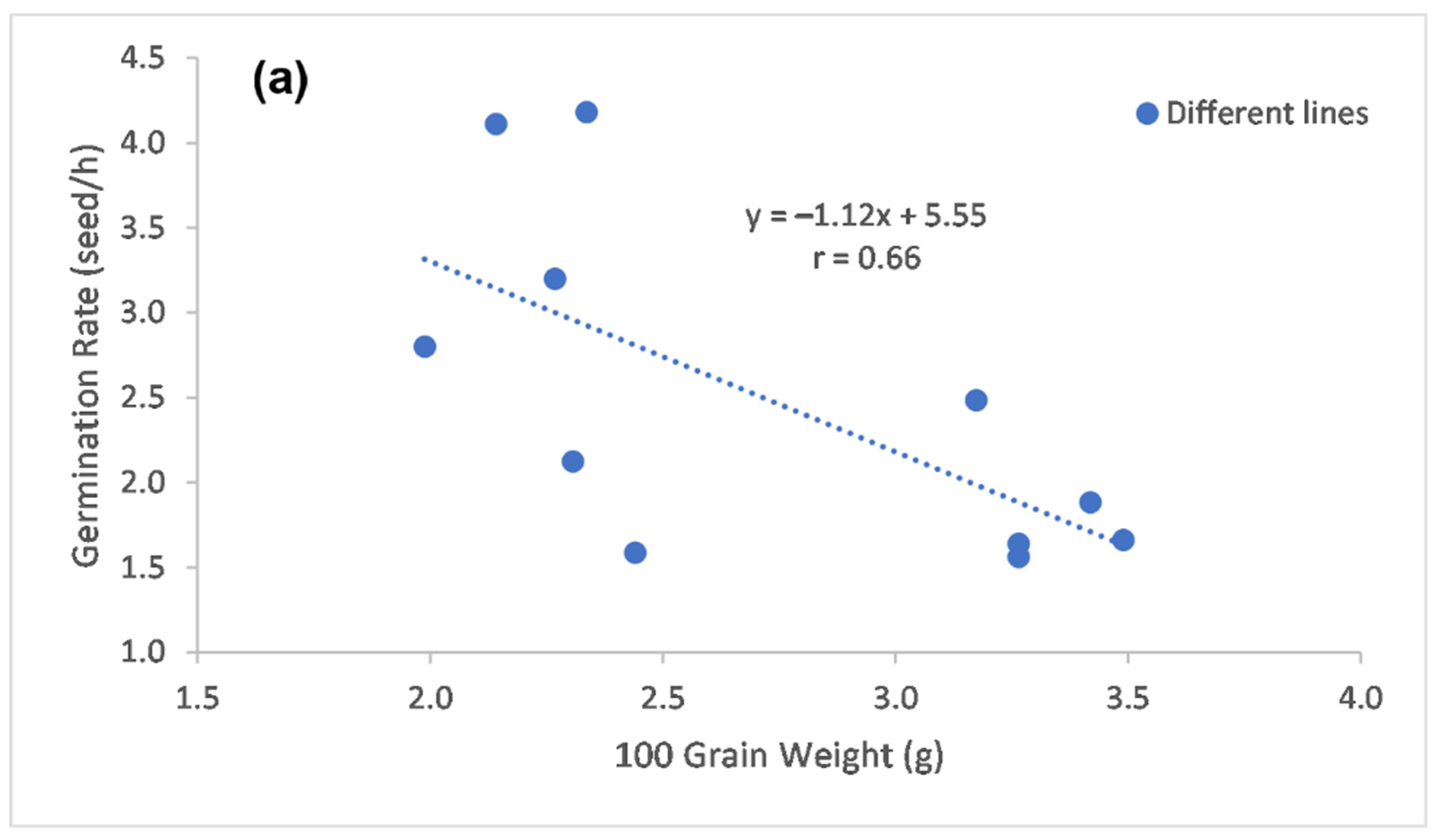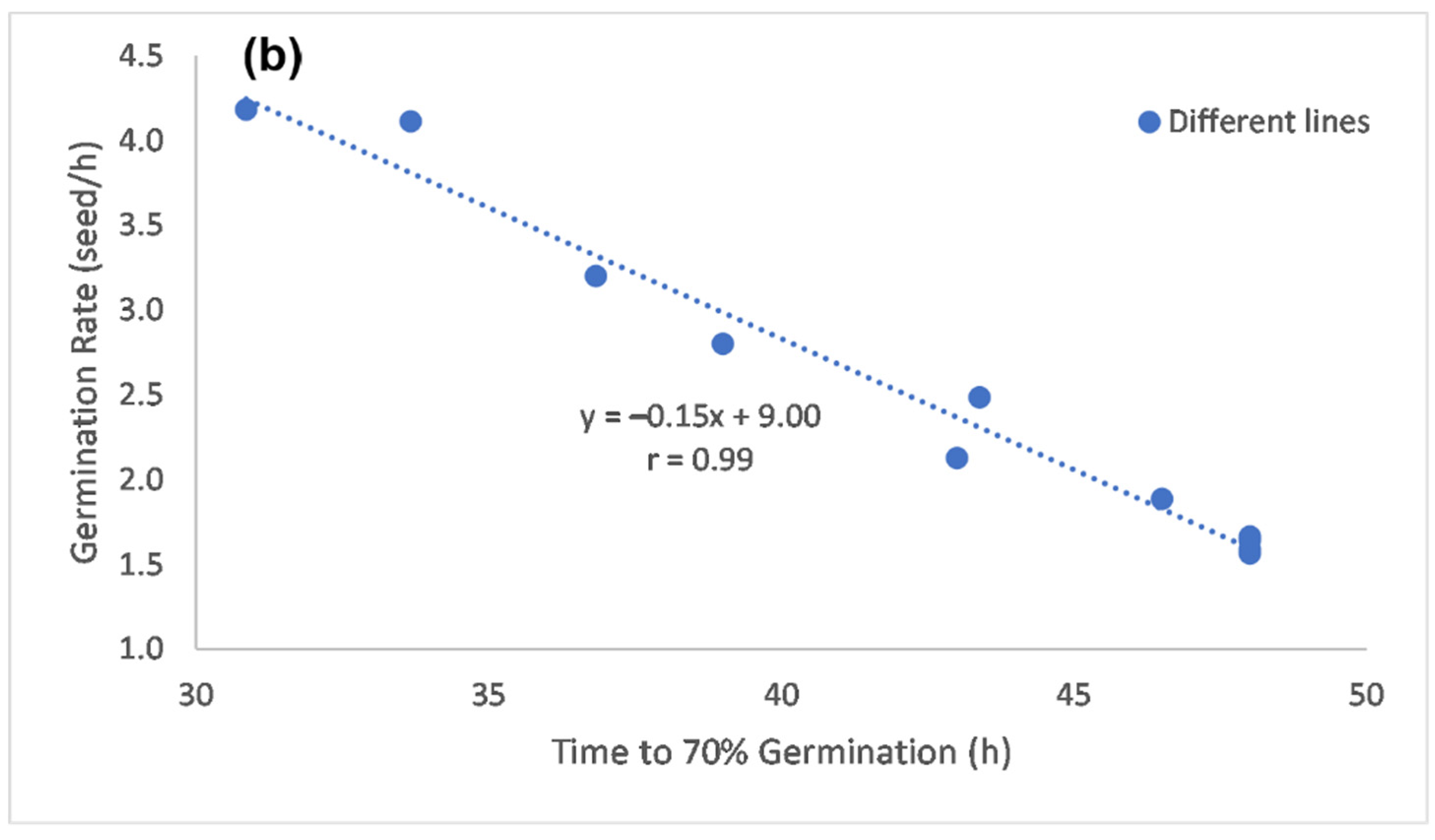1. Introduction
High germination percentage and rapid germination is important to ensure good crop establishment in the field in direct seeded rice and also for production of germinated brown rice as a healthy food. The method of crop establishment has changed from traditional manual transplanting of seedlings to direct seeding in many countries in recent years due to rising production costs and scarcity of water and labor [
1,
2]. Generally, crop establishment may be poorer in direct seeded fields. To achieve good crop establishment, seeds need to be of high quality with high germinability and rapid germination, and may also require pre-germination [
3]. Varieties with rapid germination are required for early vigor, particularly when early season drought may affect grain yield and also in weedy fields [
4,
5,
6].
Both paddy rice and brown rice (dehulled paddy) can be germinated to obtain germinated brown rice which has been found to have greater health benefits and softer texture than brown rice. Germination level of 70% is the minimum required to produce germinated brown rice [
7]. Germinated brown rice has been suggested to be beneficial in preventing some lifestyle diseases such as dietary obesity, hyperlipidemia and hypertension as well as reducing the risk of some terminal illnesses such as cancer, diabetes, cardiovascular disease, and Alzheimer’s disease [
8]. Other physiological effects of germinated brown rice include prevention of blood cholesterol amplification, enhancement of liver and kidney functions, improvement from stroke and alleviation of emotional unrest [
9]. Results from animal experiments and clinical trials revealed that germinated brown rice is a potential antidiabetic functional food that could maintain health and prevent complications in type 2 diabetes by providing a steady supply of bioactive compounds [
10]. Germination speed is important in minimizing the time to achieve germinated brown rice in food processing [
11].
The germination process of rice grain starts with water uptake, which consists of three phases including rapid, plateau and post-germination stages [
12]. At the first stage, rice grains absorb water rapidly in the first 18 h after soaking, and the grain moisture content increases gradually to 25–35% and then plateaus [
13]. The absorption of water at plateau stage is slow but the uptake increases rapidly again after the grains have germinated. Water infiltrates into paddy through the openings of fibrous cells in the hull and reaches the space between the hull and the pericarp [
14]. The water is then absorbed through the pericarp and the absorbing quantity varies upon the location of different parts of brown rice. The absorption of water is greater at the embryo than at any other part of the grain. The absorption pathway was demonstrated by Horigane et al. [
15] with two rice varieties, Koshihikari and Yamadanishiki, using three-dimensional gradient echo magnetic resonance imaging method. Rice genotype, germination conditions and type of stored carbohydrate reserves affected the duration and time scale of each stage in water uptake. El-Hendawy et al. [
12] reported significant genotypic variation in water uptake in aerobic and anaerobic conditions in 58 contrasting varieties from the IRRI collection. Water uptake rate may be affected by grain size; smaller grains often have faster increase in grain moisture content. For example, Roy et al. [
16] using the smallest and largest grains of rice cultivar BR1 with an almost three-fold difference in size, found that the smallest grain class completed imbibition process earlier and started germination earlier than the largest, although the largest grain class had higher germination percentage than that of the smaller grain.
The germination process is activated when grains have reached a certain moisture content. Grains are able to germinate at a moisture content of 25% and the most suitable condition for rice is approximately 30% [
17]. First, the embryo swells and grows, and hydrolysis of carbohydrate takes place. Then, the hydrolysates from the endosperm reserves are translocated to the embryo and the new cell materials are synthesized, which mark the germination of grain. Morphologically, the growth stage is marked by the active growth of the radicle and plumule after germination. Unlike most cereals, rice belongs to a group of plants that can germinate and grow in conditions of anoxia or submergence [
18]. The growth of the radicle is predominant when grains are germinated in aerobic conditions, whereas the growth of the coleoptile is predominant in oxygen restricted submergence conditions. In the complete absence of oxygen, there was only a 10% reduction in germination percentage in rice, while wheat germination was inhibited [
17].
Common measures used to quantify the germination process in rice include the germination percentage, germination time and germination rate. The definition of terminology used in the present work is based on the review by Ranal and Santana [
19]. The germination percentage refers to the germinability or germination capacity of grain expressed as the proportion of germinated grains. Germination time refers to the time when a certain percentage of grain is germinated; for example, germination time T
70 is the time taken from the start of soaking to 70% of the grain germinated. Germination rate refers to mean number of grain germinated per unit time, and is calculated using the following formula [
20]:
where Rg = the germination rate (grain/h),
Si = number of germinated grains at hours of counting (grain),
Hi = number of hours at which grains were counted (h),
n = time of final counting (h).
Germination of rice grain is affected by the prevailing environmental conditions of temperatures [
20,
21], salinity [
22], and moisture stress [
23], and varies among genotypes in their response to these adverse conditions. The optimal temperature for maximum germination percentage and highest germination rate was reported at 30–33 °C [
20,
21]. In their study of 13 rice genotypes from Bangladesh, Ali et al. [
21] noted that genotypes and grain physiological quality influenced the final germination and germination rate at low temperature. Among 68 mostly indica varieties, Krishnasamy and Seshu [
23] reported that the rate of germination differed among varieties following moisture stress, under low temperature (15 and 20 °C) and also with aging. Singh and Singh [
24], studying the germination response to moisture stress in four varieties of IR-28, Jaya, T-23 and IR-8, found that the germination decreased progressively in response to osmoticum solutions of −0.3 to −1 MPa, and that the decrease in germination at −0.3 MPa was smaller in IR-28 than in the others. Deka and Baruah [
25] reported that without water stress, all 10 Indian rice varieties studied reached a germination percentage above 80% but at −0.3 MPa water stress, 8 varieties had germination above 70% while at −1 MPa, only 4 varieties were able to germinate. Hakim et al. [
26], studying the effect of salinity on germination in 12 Bangladeshi and Malaysian varieties, found that when the grains were germinated in distilled water, all varieties had germination above 90% and that the difference between the variety with the highest and lowest germination was 7%. When grains were treated with salt concentration of 4 dS/m, only half of all varieties had germination above 90% and the varietal germination difference was 29%. At a salinity of 16 dS/m, only three varieties reached a germination above 50% and the germination difference was 52%.
While variety differences in germination have been examined in rice under unfavorable conditions, there are only limited studies that show genotypic variation in germination speed under favorable temperature and water conditions [
23]. Finding varieties with rapid germination and understanding the factors determining genotypic variation is important for improvement in direct seeded rice production, and also for germinated brown rice processing. The present work aimed to determine genotypic variation in germination speed and considered three aspects: importance of the hull as a barrier for water absorption and germination speed, genotypic consistency for crops grown across different years, and the effect of grain size. Germinated brown rice could be produced from paddy or from dehulled brown rice, and the examination of germination speed of these two types of germinated brown rice among different varieties also provided an understanding of the importance of the hull as a barrier for germination of paddy rice.
4. Discussion
The results of 3 years’ experiments with 8 varieties show that variety differences in germination speed of paddy rice under favorable water and temperature conditions (25–30 °C) were large, but varieties were consistent with the germination speed when grown under different conditions. The range in T
70 was 40 h among 24 diverse varieties (Experiment 7) and among the 46 Sherpa/IRAT109 genotypes (Experiment 5). While genotypic variation in germination under unfavorable conditions is well documented in relation to low temperature and water stress, for example, low temperature [
23], the present work has shown large and consistent genotypic variation in germination speed under favorable germination conditions (
Figure 4). Germination time (T
70) among varieties ranged 39–54 h in year 1, 37–59 h in year 2, and 43–51 h in year 3. Although the germination time varied over the years, there was significant correlation between germination time for any two years (r = 0.84 * to 0.92 **). Germination percentage and speed were slightly reduced when the crop was grown under water deficit, as also found by Rahman and Ellis [
28]; nevertheless, variety consistency remained in the present study. These genotypic differences in germination speed under favorable conditions are likely to have large effect in the time required for seedlings to emerge in the field, which would in turn have significant implication in early vigor and grain yield in drier conditions, particularly in early season drought in rainfed lowland ecosystem [
4,
6,
29]. Use of varieties with early vigor would be also advantageous in competing against weeds in direct seeded rice fields [
5]. On the other hand, varieties with slow germination and hence emergence would provide a greater window for application of pre-emergence herbicides [
30].
With regards to the food industry, varieties with shorter processing time (soaking and incubation time) are preferred for production of germinated brown rice because shorter soaking time can result in better control of fermentation for improved final products. Furthermore, germinated grains with lower moisture content require shorter time and less energy for drying [
11,
31].
The large and consistent variety effect was also found in the speed of water absorption and hence grain moisture content of paddy during early period of soaking, but not at the time when 70% germination was achieved. The correlation coefficient between paddy moisture content after 3 h of soaking was r = 0.86 ** for paddies for 8 varieties between Experiments 1 and 2. This consistency in the variety differences in early water absorption has contributed to the variety consistency in the time to achieve 70% germination in paddy. The varieties with higher paddy moisture content after 3 h of soaking such as Arlesienne and YRL24 required shorter germination time (T
70). While the present study indicates that the first 3 h is critical, El-Hendawy et al. [
12] found the significant relationship between water uptake rate during soaking and germination time in incubation period up to 48 h of grain soaking (r = −0.46 ***). Rapid water uptake may lead to a rapid activation of α-amylase which plays an important role in the degradation of starch into soluble sugars as the main substrate necessary for generating the energy required for the germination processes and subsequently for the rapid sugar mobilization from the endosperm to embryo [
12,
32].
Takahashi [
17] reported that grains were able to fully germinate at moisture content of 25%, however, the most suitable condition for rice was 30%. The moisture content at this level was also appropriate for the production of germinated brown rice and parboiling [
33]. Experiment 1 showed that the grain moisture content reached around 30% after 15 h soaking at 25 °C for paddy grains and 3 h at 30 °C for brown rice. These results were similar to the 12 and 4 h at 30 °C for paddy and brown rice, respectively, of Chai Nat 1 variety found by Rattanadee and Naivikul [
33]. The results of Experiment 2 also indicated that the moisture content at 70% germination varied greatly among varieties from 29% to 41%, thus the total water required to be absorbed before a set germination percentage can be achieved would vary greatly. This would have significant consequences on processing time.
In the first 3 h of soaking in Experiment 2, brown rice of 10 varieties contained on average 8–10% higher moisture content than that of paddy. Thus, dehulling increased water uptake as the water absorption into paddy rice was initially constrained by the presence of the hull, while there was no such barrier for brown rice. Studying water absorption by paddy, brown rice and hull at three temperatures with PR116 variety, Thakur and Gupta [
34] demonstrated the rigid hull enclosing the grain caused difficulty in absorbing water by paddy rice. The difference in grain moisture content continued during the germination period in the present study. This continuously higher moisture content in brown rice was also reported by Mikkelsen and Sinah [
35] who found that intact grains had 2–3% less moisture content than that of dehulled grains after 35 h of soaking. They found that dehulled grains of Caloro variety germinated more uniformly than the intact grains, but the final percentage was similar to that of dehulled grains. In addition to a physical barrier, the rice hull also contained soluble substances which have an inhibitory effect on germination [
35]. Kolahi et al. [
36] found that rice hull extracts had allelopathic effect and could inhibit the germination of wild oat by up to 27%. In the present study, the brown rice achieved T
70 19 h earlier than paddy rice. Barik et al. [
37] also found that germination time was decreased by dehulling particularly in semi-dormant rice varieties. The hull may act as a physical and chemical barrier to radical growth [
38,
39].
Experiments 1 and 2 clearly show that there were variety differences in water uptake in the early stages of soaking, but these differences also depended on grain type (paddy and brown rice) with no significant correlation for grain moisture content after 3 h of soaking between paddy and brown rice. Thus, there appeared to be significant variation in the hull barrier in water uptake in paddy, and varieties such as Sherpa which took a longer time to achieve T70 in paddy may be considered to have a greater barrier. The range in T70 was greater in paddy (36–51 h) than in brown rice (23–29 h), indicating a strong contribution of the hull barrier in determining the overall germination time.
However, there were also significant variety differences for brown rice to achieve 70% germination in Experiment 2. This was also related to moisture content in the first hour determined in Experiment 1, but not after 3 h of soaking, as moisture content of all varieties was already high, mostly exceeding 30%. Thus, rapid water uptake soon after soaking of brown rice was also a factor determining germination speed. There was a significant interaction for T
70 between genotype and grain type (paddy and brown rice) and genotypic ranking for T
70 also depended on the grain type. Thus, both types of barriers, one being the hull and the other the pericarp, would affect water absorption of paddy grain and subsequently influence genotypic differences in overall germination speed. The hull barrier may not be large in some cases; for example, Krishnasamy and Seshu [
23] found that cultivar ranking in germination rate was the same in hulled and dehulled grains among 11 varieties. Among 68 varieties, mostly indica and semidwarf, they did not find significant correlation between hull thickness and germination rate.
The range in 100 grain weight was larger in the 24 diverse varieties (1.44–3.18 g) than in the 46 genotypes derived from Sherpa/IRAT109 RILs (1.98–3.49 g). However, the germination speed (germination rate and germination time) of diverse varieties had no significant relationship with 100 grain weight, whereas the smaller grain size Sherpa/IRAT109 genotypes tended to germinate faster than the larger grains. Smaller grains would have completed imbibition of water faster than large grains and started germinating earlier than large grains, as was shown by Roy et al. [
16], Krishnasamy and Seshu [
23], and Zhao et al. [
40]. Krishnasamy and Seshu [
23] reported that 100 grain weight of 68 rice varieties, mostly semidwarf indica varieties, had a negative correlation with imbibitional rate and also germination rate. Zhao et al. [
40] compared superior grains obtained from primary branch of a panicle and inferior grains from secondary branch for the germination vigor of dehulled grains of Xinfeng 2. Superior grains had double the weight of inferior grains and it also had better structured starch compared to looser structure in the inferior grains. The inferior grains absorbed water 1.6 times faster within 6 h and had greater germination vigor in the first 24 h of soaking. Bhawana et al. [
41] found that grain weight and germination percentage (together with shoot dry weight and shoot length) were the characteristics mainly responsible for differences in germination speed among 50 aromatic rice varieties. Similarly, in the present study, a significant effect of 100 grain weight was found in Sherpa/IRAT109 genotypes, but this was not the case in the 24 diverse varieties. This may be because of the strong kinship among the RILs, as a result of genotypes emanating from a single cross (Sherpa/IRAT109), and hence the effect of 100 grain weight was detected. In contrast, the genetic background of the 24 diverse varieties differed greatly. As shown in Experiment 2, there were barriers to grain moisture absorption, and they may have masked the effect of grain size.
